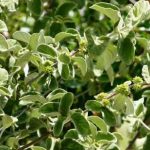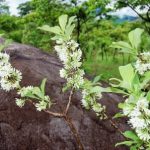TREE LIFE
April 2005
MASHONALAND CALENDAR
Tuesday 5th April. Botanic Garden Walk. Subject: “Celastraceae” – the interesting and sometimes difficult family which contains several genera with which we are familiar such as Maytenus, Catha, Pleurostylia and some that we do not easily recognise such as Pterocelastrus, Cassine, and Hippocratea. Meet Tom in the car park at 4.45 for 5 p.m.
Sunday 17th April. An all-day visit to Maringambizi in the Mutoroshanga area. This will be our third visit to this interesting spot. Bring plenty of water, your lunch and a chair for the all-day outing.
Saturday 23rd April. Mark’s walk will be on Mr. David Hatendi’s property in Glen Lorne – Charmwood. The property drops down to a river where the vegetation is always interesting.
Saturday 7th May. Botanic Garden Walk. Winter time again when the walks switch to Saturday mornings.
Sunday 15th May. A.G.M.
NOTICE OF ANNUAL GENERAL MEETING
Notice is hereby given that the 55th Annual General Meeting of the Tree Society of Zimbabwe will be held at Mr. Moxon’s property in Borrowdale on 15th May 2005.
Any proposals/resolutions and nominations for office bearers should be forwarded to P O Box 2128, Harare, by Monday 9th May if possible, although proposals and nominations will be accepted from the floor.
AGENDA
1. Notice convening the meeting.
2. Apologies.
3. Minutes of the 54th A.G.M.
4. Matters Arising.
5. Chairman’s Report.
6. Treasurer’s Report.
7. Election of Committee Members.
8. Any Other Business.
MATABELELAND CALENDAR.
Please phone Gill Short for details of the next Matabeleland function.
BOTANIC GARDEN WALK: 1 FEBRUARY 2005
Today Tom took us for a short walk through the Jesse bush of the lowveld. The Jesse is the natural dry thickets which are found particularly in the Zambezi Valley.
Tom explained that the jesse is actually the remnant dry forests which grew on the deep Karoo sands which once covered the area. This fragile forest, damaged by elephant and other species, generally no longer has the tall trees, but has evolved into a more scrubby bush, the tall trees still being found in some areas. Thus the Jesse is not simply a list of tree species, it is a combination of trees growing in association with one another, producing a landscape familiar to those who know the wild Zambezi areas.
The area in the botanic gardens is to the west of the pond and the composition of the bush is so varied that we covered only 200 yards and saw the following.
Combretum microphyllum – a striking red-flowered creeper, usually occurring in riverine habitats.
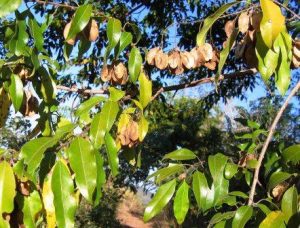
Pteleopsis myrtifolia. Photo: Stefaan Dondeyne. Source: Flora of Zimbabwe
Pteleopsis myrtifolia – 2-winged fruits, grows up to 30m tall, but generally much smaller, found in the Haroni-Rusitu forests and at the entrance to the Victoria Falls.
Xylia torreana (a member of the Mimosoideae , i.e. a legume) – which has a compound bi-pinnate leaf with only 2 pinnae and thick woody pods like Msasa.
Entandrophragma cordatum (wooden or split banana) from the family Meliaceae, which also contains the Mahogany. This species has a lovely pink wood. The leaves are compound, glossy green with a very long petiole and drip tips. Named for the pods that split to form a hard banana-like thingy with flat airborne seeds.
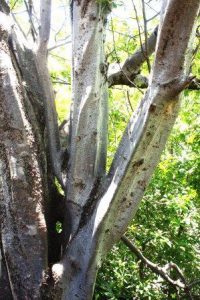
Commiphora karibensis. Photo: Bart Wursten. Source: Flora of Zimbabwe
Commiphora karibensis – from the Myrrh family. Fluted grey trunk. Pinnate leaves with relatively big leaflets. Localised distribution. Also found in the areas in Hwange where the sand has collected in the ridges of the sandstone.
Commiphora ugogensis – distinctive bark, deep green when new, peeling in small flakes and becoming deep honey-coloured. Pinnate leaves. Large round fruit, which when ripe has a red aril on the pip.
Schrebera trichoclada (wooden pear) – named after the pod which resembles a small pear. Splits in half to release winged seeds. The leaves are opposite with very distinctive veining.
Berchemia discolor grows on termite mounds. It has tiny fruits which ripen to a yellow and are definitely edible. Called “Nyii” in Shona. In the winter months, it can be distinguished by the rough bark on the bigger branches.
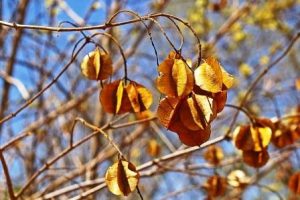
Combretum celastroides. Photo: Meg Coates Palgrave. Source: Flora of Zimbabwe
Combretum celastroides (which is the tree commonly called the Jesse bush itself – or perhaps more accurately the Jesse bush combretum) is multi-trunked with long, thin, grey young branches and forms a thicket. The bark on the older trunks flakes in large elongated chunks. The 4-winged fruit has a persistent style sticking up from the top.
Meiostemon tetrandrus is a combretum look-alike and is classified by Tom as “real jesse”. Almost a climbing shrub with very long flowering peduncles on which a single fruit develops at the end.
Philenoptera bussei (was Lonchocarpus bussei). Belongs in the legume family. It has long slender trunks, blue flowers and a pinnate leaf with an elongated and enlarged single terminal leaflet.
Excoecaria bussei – fruit very distinctive: 3-lobed and quite large (3-5 cm in diameter).
Pterocarpus lucens – beautiul battleship-grey / purple bark, yellow flowers with fairly small leaves. Varies in size from the small scrub on the Tjlotjo Cliffs to the large trees at Mana Pools.
Karomia tettensis – a species with pretty flowers (calyx mauve, corolla bright blue).
Cassia abbreviata – missing its distinctive long pods which are certainly not “abbreviated”.
Xeroderris stuhlmannii does not occur on the sands but is often found on the margin of the Jesse where the basalt encroaches on the sands. It has compound leaves with large leaflets and also red sap.
Dalbergia melanoxylon – a common species, occurring in other associations. It has small leaves.
Combretum collinum – the medium-sized fruit has rusty hairs between the wings. Smaller leafed than the other Combretum species.
Combretum zeyheri – this has the largest fruit of all the combretums. The large shiny green leaves are home to a species of mite that caused small lumps on the surface of the leaves.
General note about Combretum: they have small scales on the underside of the leaves (which you need a 30x microscope to see). These are unique to each species and are so persistent that the leaf particles in animal droppings can be identified using them. They also cause the characteristic shininess of the Combretum collinum leaf.
Grewia monticola grows everywhere including the Jesse. It has a distinctive pale underside to the leaves.
Baphia massaiensis – not only found in Miombo woodland but also common in the Jesse.
Schinziophyton rautanenii – a tree with a palmate leaf and large round fruit (the Manketti nut).
Combretum hereroensis – found in dry water courses. Small fruit.
Combretum apiculatum – a widespread species of middle and low altitudes, found on the edge of the Jesse and in the escarpment.
Dalbergia martinii – has seeds looking like an green and brown elongated fried egg. Longer leafed than Dalbergia melanoxylon and bushy.
Cleistochlamys kirkii – fruits with 3 carpels, good to eat. Flaky bark, no stipules, zigzag branchlets.
Of the over 800 species, we managed to look, albeit superficially, the 26 above. No wonder we all had mental indigestion. Our thanks to Tom who promises that next month we can have a repeat dose when we look at the plants of termite mounds.
-Linda Hyde
THETFORD ESTATE: 20 FEBRUARY 2005
Another visit by the Tree Society to Thetford Estate kindly arranged by Mark Brightman, and what an interesting day it was. It was also very nice to see such a large turnout.
It is interesting to note that our membership has ceased the decline of the last 3 years, although we have not regained lost ground. However, we are getting much larger numbers (over 30) at our main outings – even if not all those attending are actually members.
We moved off in a small convoy of vehicles towards an adjacent farm, Valeria. The road was surprisingly wet and travelling along it was surprisingly difficult – through vleis and up muddy gullies – but everyone made it, even the non-4WD vehicles and we parked in some open woodland. There we split into two groups with Rob Burrett leading one group and me the other.
The vegetation was basically miombo woodland of the type we see so often around Harare. Altitude was a bit lower, 1270m, although there was not much evidence of that in the vegetation.
One particular feature that I would like to dwell upon was the presence of a large number of suffrutices and we spent quite a lot of the walk looking at these.
Firstly, what is a suffrutex? The dictionary definition is as follows:
suffrutex (plural: suffrutices; adjective: suffrutescent)
a shrublet, usually producing flowering shoots each year from a woody, underground stock.
In other words, it is an underground woody plant and thereby persistent from year to year but dying back most years above ground.
These species are perhaps adapted to areas with frequent fires, where being a suffrutex enables the plants to survive and compete without the need to become tall, woody species with the chance of being burnt.
A nice example at this location was Annona stenophylla subsp. nana, the Dwarf custard-apple. This is rhizomatous (and therefore tends to form patches) and low-growing (typically not more 0.5 metres tall). The leaves are alternate and solitary flowers and fruits are found amongst the leaves on rather thick, downwardly-directed stalks. Both flowers and fruits are typical of custard apples, although we did not see any on this occasion.
In the same genus is Annona senegalensis, the Wild custard-apple. This is a shrub or small tree, never a suffrutex. This is a plant of lower altitudes and we don’t see it very often – certainly not near to Harare.
Another suffrutex seen was Rhus kirkii. Rhuses in Zimbabwe are generally shrubs or trees but this one is a small plant (up to c.1 metre) and dying back every year. Its leaves are 3-foliolate (although we did find an anomalous one with 5 leaflets at Thetford) and are often brownish-hairy and greyer beneath. The infl. is a pyramidal panicle. It is a common species in sandveld around Harare – e.g. in the Mukuvisi Woodland.
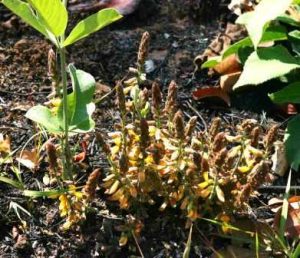
Eriosema englerianum. Photo: Bart Wursten. Source: Flora of Zimbabwe
A common legume seen was Eriosema englerianum. Typically, flowers emerge from the ground with new leaves in c.October; they are yellow-orange pea flowers and are quite striking. Later in the season, the leafy stems appear; they may attain 1 metre or more and bear 3-foliolate leaves which are almost sessile. Typically it is a suffrutex and everything dies back or is burnt back and the plants start again each year.
Occasionally, an englerianum does not die back; the woody-ish stems persist and flowering may take place from these stems, not from the ground as usual. However, as far as I am aware, this plant never becomes a permanent woody shrub.
Fadogia ancylantha (the Makoni tea bush) is yet another suffrutex. Common around Harare in open woodland, its rather broad, bushy stems have branches in whorls of 3, as also are the leaves. This is a Rubiaceae and has the typical interpetiolar stipules; 3 in total, one between each pair of leaves in the whorl.
Up the hill, we came across a specimen of Ochna gambleoides. Maureen reminded me that we had seen it in this area before. It’s a local species with us and always nice to see. There never seems to be many specimens at any one place. The last time I recall seeing it was at Mazvikadei in April 2004. The leaves have the typical raised upper vein of ochnas but are much larger with a thick texture and a grey colour. They look a bit like a protea leaf.
At the highest point of our walk we began to get into the rocky flora and began to encounter Brachystegia glaucescens, the Mountain acacia. There also we entered a small, shady, stream bed and came across the distinctive evergreen Mimusops zeyheri. In the shade grew a species of Oplismenus (a grass genus typical of forests) and there, too, were the white flowers of Pentas angustifolia.
Our return to the main offices at c.12.30 was much easier as, by then, the road had dried out.
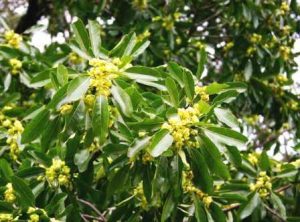
Uapaca nitida. Photo: Bart Wursten. Source: Flora of Zimbabwe
After lunch, Mark offered to drive us around the estate and a small group of about 10 of us were conducted in style and comfort on a modified Land Rover. Occasional stops were made to see trees of interest. Perhaps the most interesting was a species with quite striking yellow flowers, the name of which defeated us for a while; eventually we realised it was Uapaca nitida, the Narrow-leaved mahobohobo.
This is fairly frequent in places to the north of Harare; we saw it at Christon Bank last year and also in fruit at Barbara Scheidler’s place near Mutoroshanga; however I had never seen it in flower before. The flowers are very like Uapaca kirkiana, the normal mahobohobo.
We also made some stops to sex the normal mahobohobos we kept seeing – oddly they were all males! Are there no females at Thetford?
After a long-ish drive we arrived at the boma and in the late afternoon watched the roan coming in to be fed. There were no rhino to be seen, but as luck would have it, we came across those just as we were driving away and back to the main estate offices.
To sum up, a marvellous day, which was made what it was by the time given and the trouble taken by Mark Brightman. Our great thanks go to him – and we look forward to more visits in the future.
-Mark Hyde
THE PETHERAM FILES File 4. Binga-re-dunduru
Dick Petheram’s File 4, labelled Sacred Trees and Protection of Forests, contained copies of correspondence between various officials relating to the proposed reservation and protection of an area of swamp forest in the Chiweshe Communal Lands, to the north of Glendale. Included in the file were notes written by the late F L Orpen, of the Forestry Commission, who originally drew attention to the forest. Orpen served with the Forestry Commission for 45 years before his retirement in 1974; this was followed by seven years with the Department of the Surveyor General, then two years on contract with the Research Division of the Forestry Commission before his sudden death in 1983 at the age of 72.
What follows is a composite of the correspondence and Orpen’s notes.
A little more than one kilometre to the southwest of Banje peak, near the northern boundary of Chiweshe Communal Land, there is an area of swamp forest known as Binga-re-Dunduru. With such an imposing name one might expect an extensive tract of forest—but it covers only about two hectares. The Shona name Binga-re-Dunduru means “the forest on the Dunduru River”, and Orpen came across it in October 1967 while he was out on a Forestry Commission assignment to find suitable land for a eucalypt plantation for Chief Makope’s people.
Orpen wrote: I was most impressed with this small forest and my immediate reaction was that something should be done to preserve it. It was obvious that local cultivation was eating into the fringing vegetation fairly rapidly. Cattle and goats were allowed to wander into the shade of the large trees, and would drink at the stream. Slowly this neglect would ruin the area, resulting in the disappearance of the trees and ferns—and eventually of the water.
Orpen, a fluent Shona linguist, first approached Chief Makope to try to persuade him to preserve the forest, but subsequent visits at fairly long intervals indicated that little, if anything, was being done. This led Orpen to the District Commissioner at Concession, who was responsible for the administration of the area, and finally he went to see WB Cleghorn, at that time Officer in Charge of the National Herbarium and Botanic Garden. Cleghorn was most interested, and wanted to see the forest. This was soon arranged, and a detailed inspection of it was made in October 1971.
The dominant tree species in the forest at that time was Syzygium cordatum (waterberry) and Bridelia micrantha (mitzeerie). The larger trees had heights of 20 m and diameters of 80 cm. Twenty species of trees and shrubs were recorded in the understorey, three species in the herb layer, and 18 species of trees, shrubs, climbers and herbs on the forest margin—a rich flora, indeed, for so small a forest. Many of the species in Binga-re-Dunduru are common in and around the kloof forests of the eastern border mountains, and elsewhere in the better-watered parts of Zimbabwe, but Binga-re-Dunduru is one of the few known swamp forests in the country.
Following his visit to the forest with Cleghorn, Orpen had several discussions with the District Commissioner and his staff, and finally a meeting of all parties, including the Chief and his headmen, was held at the forest on 25 July 1972.
The significance of the swamp forest and the reasons for wanting it protected were explained, and the District Commissioner gave the meeting a discourse on the legal aspects of reservation. Chief Makope and his headmen were then asked what they felt about the project, and after some discussion the Chief said his people felt the area was already protected by a mudzimu (spirit) known as Mutowa. No one would dare enter the forest to cut a tree for fear of angering Mutowa, who would instruct the wild animals in the area—baboons, monkeys, bushpigs, porcupines, and the rest— to descend on the transgressor’s lands and livestock, and ruin them all.
It was then suggested that the forest should be demarcated by fencing or beaconing, but the gathering was averse to that, too: Such action would detract from the authority of Mutowa, and cause him to lose interest in the forest, necessitating the appointment of a human guard to do his work. The District Commissioner asked the Chief and his people to consult Mutowa to determine whether he might, perhaps, require the assistance of a fence in his task of protecting the forest, and to report back in due course. Two senior headmen were immediately appointed to the task, but, as far as Orpen was able to discover, nothing further was done.
A humorous distraction was provided at the meeting when numerous vervet monkeys congregated within 20 m of the participants, apparently listening to all the discussion, and giving the impression that they were the appointed guardians of the forest!
The 1:50 000 map reference for Binga-re-Dunduru is 1631C3 US053354.
Before leaving the Chiweshe area it might be worth mentioning another, smaller pocket of forest at the western end of Nyota Mountain, where the main road to and from Chiweshe passes along the foot of the mountain. “Here”, Orpen wrote, “are some large Bridelia micrantha, a small Olea europaea ssp africana (wild olive), several quite large Syzygium cordatum, and quite the largest Stereospermum kunthianum (pink jacaranda) I have seen anywhere. Also growing on the rock face of the mountain are Ficus sur (Cape fig) and Hymenodictyon floribundum (red firebush).
The 1:50 000 map reference for this spot is 1731A1 TS914006.
Extracts from
THE TREE LOVERS OF PERSIA (IRAN) AND THEIR TREES
By Gertrude Ordman
From A. J. Arberry’s ‘The Legacy of Persia’
King Artaxerxes, son of Xerxes, halting during a march with his army in midwinter at one of his royal gardens, gave permission to his soldiers to cut down trees for fuel. The soldiers, however, overcome by admiration of the cedars and cypresses, refused to lay their axes to the trunks till Artaxerxes himself set the example by cutting down the finest tree with his own hands.
In Persepolis in the south of Iran can still be seen the ruins of the palace built some 2500 years ago by King Cyrus, founder of the Persian Empire. It is related by the Greek historian Xenophon how Cyrus personally conducted Lysander around his garden at Sardis. Lysander was full of admiration for the beauty of the trees, the accuracy of their spacing, the straightness of their rows, the regularity of their angles and the profusion of sweet scents wafting from the trees. Lysander exclaimed at the skill of the Agent who had measured everything so exactly. Cyrus proudly replied that the whole of the measurement and arrangement were his own work and that he had even done some of the planting himself. When Lysander, looking at him and observing the beauty and perfume of his silken robes and the splendour of the jewellery he was wearing, remarked: “Did you really plant part of this with your own hands?” Cyrus assured him that it was indeed so and added that never had he sat down to dinner, when in sound health, without first working hard at some task of war or agriculture.
A visit to Iran, formerly Persia, showed that interest in trees and tree planting, is still manifested today. An annual National Tree Planting Day is set aside in modern Iran.
Trees, especially the Asiatic Plane, are seen commonly in the streets of towns and villages, giving welcome shade. It is said that the ancient Persians believed the Plane tree was a safeguard against plague.
The Persians love their fruit trees – peaches, apricots, apples, cherries as well as the pomegranate and others. The peach was introduced into Europe from Persia by Alexander the Great. They also love their nut trees and enjoy the nuts – pistachios and almonds, which are seen for sale in great mounds on the pavements of the towns, a vendor squatting beside them with scale and wrapping paper.
In the past, as in most countries, there has been exploitation and misuse of the natural forests, which in Iran are chiefly found in the region of the Caspian Sea. The indiscriminate grazing of goats destroyed young saplings, and trees were cut down for timber, firewood and charcoal. The old charcoal braziers, still used in outlying villages, are slowly being replaced by kerosene heaters.
Goats are still found in large flocks along with sheep in the country districts. One meets peasant women walking unconcernedly along, dangling small, roughly-constructed wooden wheels which spin black goat hair into wool for Persian carpets.
More than half of Persia’s million square miles is treeless desert and water is the great problem of the country. One travels through sandy wastes for hundreds of miles without seeing vegetation of any kind. Even the great mountain slopes are bare. But wherever water from the melting snow of these mountains has been led through underground channels to a town or village there the Persians have planted their precious trees.
From “Trees in South Africa” Oct – Dec 1964
Acknowledged with thanks
HISTORIC TREES OF ZIMBABWE By LYN MULLIN.
Copies of this wonderful book are still available from Maureen Silva-Jones.
Telephone. Home 740479; Work 757171(Harare)
Prices: Soft Cover – $90 000 back in stock.
Hard Cover – $150 000
Leather Bound – $200 000
MARK HYDE CHAIRMAN


